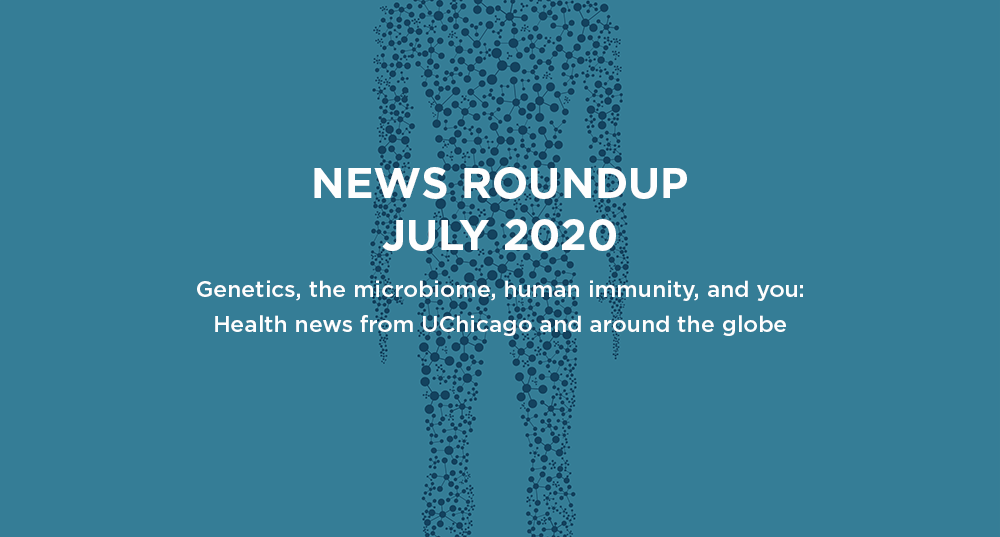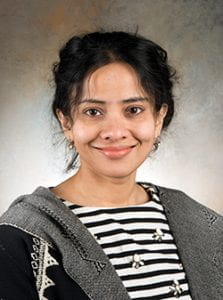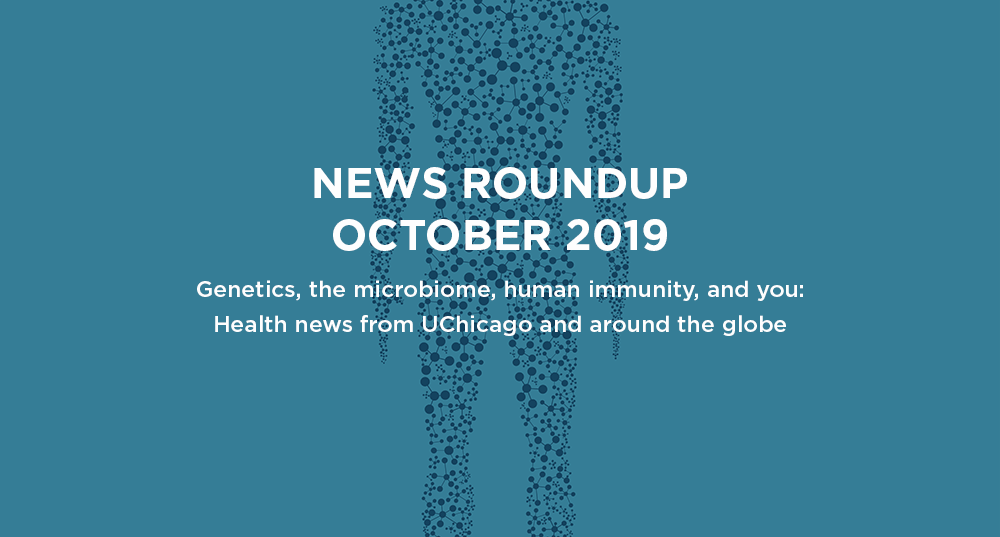
Dec 23, 2020 | Breastfeeding, Genetics, Microbiome
by Elise Wachspress
One of the goals of the Duchossois Family Institute (DFI) is to understand how our own individual genes, those of the microbes cohabiting with us, and the many metabolites they produce all work together to create healthy, robust biological systems—or fail to do so.
Over the past century, medical science has shown great success in creating drugs and other treatments that address human ailments and extend lifetimes. It excels in rescuing people from acute disease and fighting pathogens (like developing multiple vaccines against a new and evolving virus within less than a year). The important challenge before us now—less apparently heroic, but potentially much more powerful—is to reduce vulnerability to chronic diseases, a problem escalating all over the world, even in developing countries.
The DFI was created around a central question: what if we could tune the factors involved in human health to achieve and maintain vigor throughout our lives? If science could help humans become their most robust selves, societies around the world stand to gain in happiness and productivity, rather than just increased longevity.
To achieve this goal depends on a new kind of interdisciplinary science, one that can make sense of the endlessly complex interactions among human gene products, microbial genes and metabolites, the foods we eat, and the chemicals in our environment. To do this most rationally and efficiently, Arjun Raman, MD, PhD, wants to focus on discovering the most basic principles that underlie the structure, function, and adaptability of these relationships.
We have, he believes, a surfeit of data already captured in electronic health records, complex genetics studies, and many more sources. Now we must leverage these data, using computation, theory, and experiment, to unearth the biological “wiring diagram” that will allow us to rationally engineer solutions for human health.
In a recent paper in Science, Raman and colleagues proposed to attack this issue at the level of one critical “food web,” one both simple and complex: the “triad” of mother, newborn, and breastmilk.
We know that breastfeeding supports infant health and development and influences later cognitive ability or risk for conditions like obesity or diabetes. Studies have also suggested that nursing seems to provide lifelong health benefits to the mother, including decreased risk of sex-related cancers and cardiometabolic disorders.
While vast caches of data at the population level demonstrate these correlations, we still don’t really understand exactly how these work. By figuring out the mechanisms involved, we can identify the most critical elements, so moms—and whole societies—can set their children on a path for vigorous good health. This is especially important in cases where babies are born prematurely or in resource-limited environments, when mothers’ bodies are unready or unable to provide the nutrition babies need.
In their paper, Raman and company argue that breastfeeding is a co-adaptive system and breastmilk a “live tissue” with not only macro- and micro-nutrients, but also essential bioactive compounds (like the chemicals that give structure to the fat droplets critical for brain development), micro RNAs, even cells and microbes. In fact, the nutrients in breastmilk may initially be more important in feeding the essential microbes in babies’ guts as they are for the children themselves.
What are the factors most important for the child’s microbial community to thrive and spur robust development? In babies born too early or at an environmental disadvantage, what are the best ways to repair the gut community? How does breast milk change over the nursing arc? How do the interactions between the genomes—mother, child, microbes—and the environment work together—or not—to maximize healthy growth?
Finding the answers to these questions can help us figure out how to save the lives of babies at risk. But Raman is looking for much more. By figuring out the basic principles that guide these factors and how they relate to each other in the earliest days of life, perhaps science can develop theoretical constructs that can accelerate breakthroughs, much like the theory of gravity or the periodic table or Darwinian evolution have provided powerful “shortcuts” to discovery in physics or chemistry or biology.
Raman was attracted to come back to UChicago—where he earned two undergraduate degrees—after years of study in medicine, clinical pathology, and molecular biophysics, at Washington University and University of Texas Southwestern, because he believed the resources at the DFI, with access to great expertise in computation, microbiology, genetics, and diverse clinical populations, is the perfect place to start generating useful theory.
One day, he believes, we will be able to develop health strategies and risk stratification for individuals in a data-driven way. Perhaps we’ll be able to use inflammatory markers to help create a “tuning device” for health, with personalized combinations of foods providing the “push” to adapt and repair the gut microbiome of people at genetic and environmental risk for disease.
Raman’s work has already helped colleagues have made inroads in this effort for malnourished children in Bangladesh. It’s an effort that could help completely change the way we think about medicine. And elevate opportunities for vigor in people everywhere.
Elise Wachspress is a senior communications strategist for the University of Chicago Medicine & Biological Sciences Development office

Jul 31, 2020 | COVID-19, Genetics, News Roundup
Do plants hold a key for understanding our own immune systems? Researchers identify plant genes that select which microbes get to live inside leaves, safeguarding plant health. (Futurity)
Historical studies of infants’ poop suggest their microbiomes are more malleable than adults’. Research suggests probiotics may have the power to improve the health of those under two years. (The Scientist)
Are worldwide increases in inflammatory bowel disease worldwide caused by mothers passing on their microbiomes to their children? Researchers are finding gut microbiota alterations in IBD moms persists during pregnancy and are reflected in the microbiota of their infants’ stool, potentially changing their adaptive immune systems. (Gut Microbiota for Health)
Researchers are identifying some factors to predict who becomes sickest with COVID-19 infections. High levels of cytokine alpha interferon and inflammasome activation increase severity, but high levels of cytokine “growth factors” is a positive sign. (MedicalXpress)
Do those with IBD have more reason to worry about COVID-19? Data so far suggest not. UChicago’s David Rubin, MD, suggests IBD patients on immunosuppressants continue their medications but maintain a social distance regimen. (Health Central)

Dec 19, 2019 | Biology, Genetics, Genomics
by Elise Wachspress
Before the Olympian deities worshipped by the ancient Greeks, there were their ancestors, the Titans. The stories about both sets of gods would put our own Game of Thrones to shame for their high drama, grisly battles, multiple plot twists, and huge, convoluted casts.
The Titan Atlas led the Titanomachy, the war challenging the upstarts, which was decisive. The next-gen Olympians won, and Atlas was forced to carry the weight of the heavens—the universe, to the Greeks—throughout eternity.
Many centuries later, geographer Gerardus Mercator envisioned an encyclopedic portfolio of documents that included not just a collection of maps but also descriptions of the creation and form of the entire universe, or at least what was known of it in the middle of the sixteenth century. Mercator called his creation an “atlas,” named for the Titan who carried the heavens on his shoulders.
Since then, people have commonly called a book of maps an “atlas.” But, like Mercator’s original compendium, the best atlas is one that shows not just where, but how, when, and why.
In October 2016, a group of world-leading scientists met in London to discuss creating an atlas of the cells in the human body—a tool that would help describe and define the cellular basis of health and disease. Like the Human Genome Project, the Human Cell Atlas (HCA) initially looked like an overwhelmingly difficult quest. The scientists wanted to identify each unique cell type, describe how they work together to form tissues in three dimensions, and understand how all the body systems were connected. They needed to know which genes were active in which parts of the body and how each different cell type was produced.
As with the Human Genome Project, the only possible approach was to enlist a huge coalition of experts in biology, medicine, genomics, data analysis, software engineering, and visualization. Like the cast of thousands employed by Game of Thrones, groups would follow their own individual plot lines, coming together as the project grew.
Also like Game of Thrones, budgets would be high. Luckily, major foundations, including The Leona M. and Harry B. Helmsley Charitable Trust, the Wellcome Trust, the Chan Zuckerberg Initiative, and many others stepped in generously to make the work possible and accelerate progress.
The project would have been impossible without scientific breakthroughs in “single-cell technologies.” Researchers needed the ability to isolate individual cells, increase the amount of DNA and RNA within each sufficient for sequencing, see which genes were expressed (i.e., made into proteins) in each, and watch how those proteins powered that particular cell. Looking at a group of cells would just show how cells operated on average, with little information about how each individual cell contributed to the creation of tissues, organs, systems, immunity—and the health of the human person over all.

Anindita “Oni” Basu, PhD
Needless to say, many of the leaders in the new field of single-cell technologies are young, and UChicago has one of its pioneers. Anindita “Oni” Basu and her lab are not only adept at isolating and studying single cells, but they can do so quickly for multiple cells isolated from their native environments. Basu has profiled thousands of cells at a time, and, with her joint appointment at Argonne Laboratory’s Center for Nanoscale Systems, is constantly developing new tools to study inter-cellular interactions in complex biological systems.
Thus it was no surprise when Basu received a grant of nearly $3 million from the Helmsley Charitable Trust for a collaboration with other groups to help develop a “Gut Cell Atlas.” The goal is to better understand Crohn’s disease, a serious inflammatory bowel disease that causes abdominal pain, severe diarrhea, fatigue, weight loss, and even malnutrition. Basu and her team will not only identify and characterize gut cell types in those with and without Crohn’s, but also create “organoids,” lab-grown models of gut tissue, to study the mechanisms of Crohn’s disease in the lab and identify actionable targets for therapeutic interventions and disease prevention. Like Mercator’s atlas, the Gut Cell Atlas will be much more than a mere collection of maps.
Helming a large team that includes Crohn’s disease specialist Gene Chang, MD, and statistical geneticist Matthew Stephens, PhD, and set in an environment with a NIH-funded Digestive Diseases Research Core Center and strong clinical leadership in inflammatory bowel diseases, Basu has the perfect environment collaborate on building the Gut Cell Atlas.
It’s a big universe on Basu’s shoulders. But the knowledge she, her team, and others will develop over the next three years can create a foundation for new drug development and diagnostic tools, critical in an episodic disease like Crohn’s, where catching a flare-up early can significantly reduce disease progression. If her team can demystify the unknown, chart territories now marked “Here Be Dragons,“ and ultimately win this war, there will be smoother sailing ahead for the estimated three million people in the US with Crohn’s disease.
Elise Wachspress is a senior communications strategist for the University of Chicago Medicine & Biological Sciences Development office

Oct 30, 2019 | Commercialization, Genetics, Microbiome
A selection of health news from the University of Chicago and around the globe curated just for you.
In the pancreas, common fungi may drive cancer
A new study found that certain fungi can settle in the pancreas, where the spur the growth of tumors. (New York Times and ScienceDaily)
Genetic differences in the immune system shape the microbiome
UChicago researchers showed that while the bacteria to which mice were exposed largely determined their resulting microbiome, genetic differences played a role as well. Drs. Chervonsky, Golovkina, Khan, and Antonopoulos featured. (The Forefront)
Polsky Center named the 2019 NASDAQ Center of Entrepreneurial Excellence
The award, presented at the annual Global Consortium of Entrepreneurship Centers, represents the highest honor that university entrepreneurship centers can receive. (Polsky Center)
PTSD nearly doubles risk for infections
The study found that PTSD affects infection risks for men and women differently, having, for example, more of an effect on a woman’s risk of urinary tract infection and a man’s risk of skin infection. (Futurity)
A new CRISPR technique could fix almost all genetic diseases
A less error-prone DNA editing method could correct many more harmful mutations than was previously possible. (WIRED)

Sep 18, 2019 | Genetics, Immunology, Microbiome
In 2017, the University of Chicago Medicine established the Duchossois Family Institute: Harnessing the Microbiome and Immunity for Human Health (DFI). The institute is dedicated to developing new knowledge about human biological defense systems, including the microbiome, and their potential for preventing disease and maintaining lifelong wellness.
After a national search, renowned physician-scientist Eric G. Pamer, MD, was recruited to become DFI’s inaugural director in July 2019. Formerly with Memorial Sloan Kettering Cancer Center, Pamer is tasked with building the DFI’s research capabilities, from recruiting new faculty and building core facilities to translating discoveries into treatments that can be used in the clinic. UChicago Medicine spoke to him about his plans, and what he hopes to see the DFI accomplish.
Read the full Q&A on “The Forefront” >>

Aug 22, 2019 | Genetics, Microbiome
by Jordan Greer
Imagine feeling that simple cold, jog, or even a garden stroll could turn into a life-threatening event. Against your will your breath becomes labored and each inhalation becomes shorter until you feel like you are being choked by your own body.
This is a common fear for those suffering from asthma, which has claimed the lives of many. And while the effects of asthma are widespread, the African-American community continues to be disproportionately affected. According to the University of Illinois Community Assessment of Needs 2016, the percent of African-American asthmatic patients with asthma in Chicago is nearly triple that of their white counterparts and twice the US average.
To combat this disparity, the UChicago Medicine Urban Health Initiative and its collaborators recently launched the Asthma Resource Line, 1-833-3ASTHMA (1-833-327-8462). This toll-free number links community members with caregivers to create an informed dialogue about asthma-related community resources. Brenda Battle, vice president of the UHI, says the line provides both “a one-stop, convenient, and reliable source of information and a pathway for children in the community to get access to the care they need.” The South Side Pediatric Asthma Center operates the line to increase support, especially for those in the University’s neighborhood, the South Side, where there is a disproportionately higher rate of asthma diagnoses.
But what actually causes asthma? On one hand, air quality has been implicated in both initiating the disease and triggering attacks, with smog and vehicle exhaust identified as major culprits. These issues have an even more pronounced effect in Chicago, which the American Lung Association ranks as the 18th most ozone polluted city in the US, with an “F” rating for air quality.
While environment certainly plays a role in asthma, DNA is also a key player in predisposing the Black and Latinx communities to higher rates of the disease. To better understand the genetic factors that lead to asthma both in childhood and later in life, UChicago researchers Carole Ober, PhD, Hae Kyung Im, PhD, Milton Pividori, PhD, and Nathan Schoettler, MD, PhD, recently conducted the largest asthma-related genome-wide association study of childhood-onset asthma and adult-onset asthma. By comparing differences in the DNA of asthma subjects to controls without asthma, they could find genetic variations that may contribute to the onset of these conditions.
They analyzed the genetic data of over 300,000 people from a UK biobank–a repository for biological samples and clinical data. Using this massive data set, Ober’s team could elucidate which genes were associated with early and late-onset asthma.
Their results suggest that while both childhood and adult asthma share an immunologic component, childhood asthma is more heavily influenced by genes involved in other common childhood allergic diseases, like eczema and food allergies. Adult-onset asthma, on the other hand, is more likely to be triggered by environmental factors. Ober and her team’s work thus provides insights to possible genetic pathways that can eventually lead to treatments better tailored to children with asthma, while also suggesting that adult asthma and its complications may be improved by reducing exposure to triggering environmental factors.
Other UChicago studies are looking at how the microbiome, the community of microscopic organisms that live on or within us, plays a role in asthma development. The lungs, much like our skin, gut, and mouths, have their own specific communities of bacteria and fungi which may change in response to disease and indeed make a disease worse.
Steve White, MD and his team have helped confirm that patients with asthma have unique assemblages of microbes residing within their airways. They took swabs of the bronchi, the passages that lead into the lungs, and sequenced the DNA of microbes present in both asthmatic and non-asthmatic patients. Not only did they find evidence for unique bacterial and fungal communities within the airways of asthma patients, but also that the fungi present could help predict the patient’s type of asthma. These results could lead to the creation of biological tests that will help clinicians personalize asthma treatments for their patients.
As US asthma incidence increases (according to the Centers for Disease Control and Prevention, by 28 percent from 2001 to 2011 alone), the over 25 million people currently suffering from the disease and their loved ones can take heart from the work that UChicago is doing to address this growing problem. By tackling asthma with scientific research and community-centered support, a time may soon come where we can all breathe a little more deeply.
Jordan Greer is an Evolutionary Biology graduate student and science communication intern from the University of Chicago.










